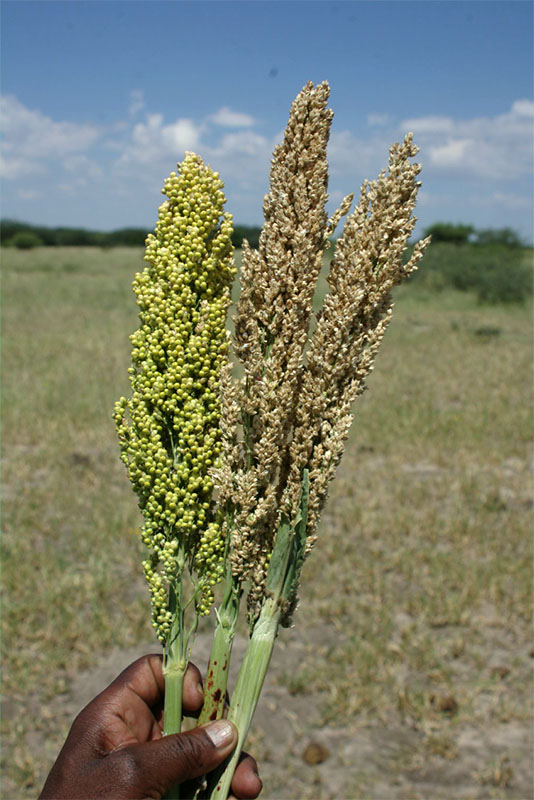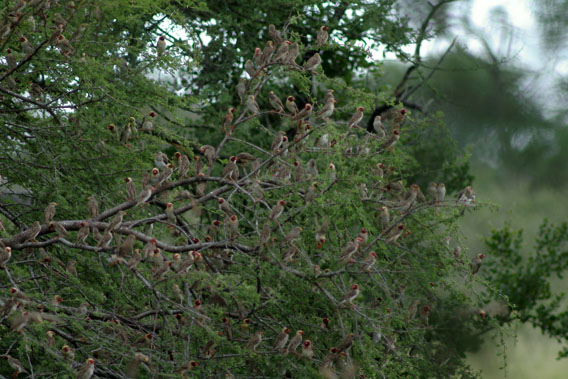In the first week of January 2013 Professor Bob Cheke from the Natural Resources Institute (NRI) will appear on the new BBC Nature TV series ‘Nature’s Weirdest Events’ which will unpack the science behind strange and amazing events in the natural world. The programme will cover topics ranging from the bio-control of invasive fire ants in America to unusual cloud formations. Bob will advise on the swarming nature of the Quelea birds and their threat to crops. A flock of 2 million birds can destroy up to 50 tons of grain per day.
The Red-billed Quelea (Quelea quelea) is the world’s most numerous terrestrial bird with a population estimated at 1,500,000,000. The birds live only in Africa. They normally feed on wild grasses, but when these run out, the birds will find a small-grained crop and attack it. Thus, fields of cereals such as millet, sorghum, rice and wheat, belonging to smallholders and commercial growers alike, can be destroyed by huge swarms of the birds causing up to US$ 70,000,000 worth of damage per annum in Africa.
Quelea do not attack maize as its grains are too large for them to cope with, so some farmers grow maize in sub-optimal conditions to avoid bird attacks. However, maize requires much more water than millet or sorghum, so if the rains fail the tactic is risky.
There are three subspecies of quelea, each with their own migration patterns depending on rain-front movements. The birds can cover distances of up to 3,000 km. The migration routes and other aspects of quelea ecology were elucidated by the late Peter Ward and Peter Jones, assisted by Joyce Magor’s biogeographical studies of the birds, during the 1960s and 1970s when they all worked for the Centre for Overseas Pest Research, one of NRI’s antecedents.
 As the birds are such serious pests, it is necessary to the lives of millions of smallholder farmers that they are controlled to prevent devastating crop losses or local famines, such as those that occurred in 1881 and 1942 in parts of Tanzania. Nowadays, control measures and emergency food provision usually prevent famines but in 2009 relief agencies reported quelea birds directly affecting food security in Kenya, Malawi, Mozambique, Namibia, Tanzania and Zimbabwe.
As the birds are such serious pests, it is necessary to the lives of millions of smallholder farmers that they are controlled to prevent devastating crop losses or local famines, such as those that occurred in 1881 and 1942 in parts of Tanzania. Nowadays, control measures and emergency food provision usually prevent famines but in 2009 relief agencies reported quelea birds directly affecting food security in Kenya, Malawi, Mozambique, Namibia, Tanzania and Zimbabwe.
Conventional control tactics exploit the birds’ social habits, targeting them in their communal roost sites or nesting areas, which may have 30,000 nests per hectare or 6000 nests per tree, with poison or explosions.
Since 1996, NRI teams led by Bob Cheke have been working on reducing the environmental impacts of control methods. They have developed forecasting methods to improve the targeting of controls, assessed the ecological damage to see how best to mitigate against it, and they have tested trapping methods to substitute for sprays and fire-bombs. Such trapping techniques reduce the environmental impact and have the added advantage that uncontaminated birds can then be used as a food source with much-needed protein for hungry populations.
Successes in catching the birds for food instead of spraying them have been achieved in Tanzania using nets or traditional basket traps and wire-mesh copies of the baskets, leading to income generation for the trappers and roadside food vendors.
BBC series ‘Nature’s Weirdest Events’ will be shown on BBC2 in the first week of January, for more details: http://www.bbc.co.uk/programmes/p00msn5h
Red billed quelea bird swarm on BBC series Planet Earth with Sir David Attenborough (for which Bob Cheke also provided advice on where and when to film quelea) http://www.bbc.co.uk/nature/life/Red-billed_Quelea#p00381fg


